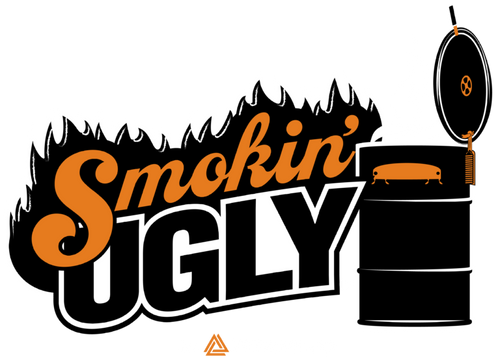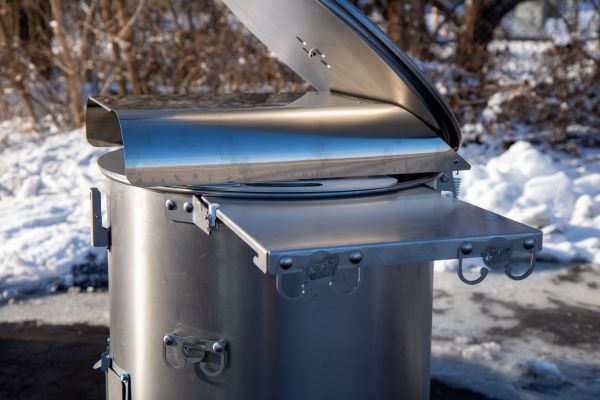For as much as we'd like to say the #1 rule about meat smoking and BBQing is "Have fun," it's simply not.
We'd argue it's a close second.
What's the #1 rule?
That's a no-brainer, and it's one that applies to most other things in life: "Safety first."
While it's easy to get caught up in the fun of smoking meat and BBQing with your ugly drum smoker (UDS) or grill, remember: you're still working with high temperatures, smoke, raw meat, and sharp objects.
To help you enjoy meat smoking and BBQing the most important way – safely – we've created a few handy meat smoking and BBQ safety checklists.
Meat Smoking and BBQ Safety Checklist #1: General Tips
No matter what you're cooking on your ugly drum smoke or grill, here are a few base-level meat smoking and BBQ safety tips to keep in mind every time:
Fire Safety
- Keep a Fire Extinguisher Nearby: This one – in our view – is non-negotiable. Always have a fire extinguisher accessible within a few steps of your cooking area. Familiarize yourself with its operation so you're prepared to act swiftly in case of a fire.
- Establish a Safe Area Free From Flammable Materials: Set up your smoking or grilling area away from any structures, trees, and materials that can catch fire. Maintain a clearance of at least 10 feet from your house or any outdoor structures. Remove any dry leaves, paper, or other combustibles from the vicinity of your BBQ to prevent accidental fires.
Personal Safety
- Use Protective Gear Like Gloves and Aprons: High-quality, heat-resistant gloves are essential for handling hot grates, pans, and food safely. They prevent burns and ensure a secure grip, reducing the risk of accidents. An apron is also recommended to protect your clothing from grease, sparks, and stains.
-
Be Mindful of Hot Surfaces and Sharp Tools: Treat every surface and tool as if it were hot. Use long-handled utensils to maintain a safe distance from the heat and flames. Keep sharp tools such as knives and skewers organized and out of reach of children.
Meat Smoking and BBQ Safety Checklist #2: Before
Before firing up your UDS or grill, there are a few checks you'll want to run through to ensure everything goes smoothly.
For Your UDS/Grill
- Give Your UDS a Thorough Inspection: Check for any signs of wear and tear — things like damage, rust, or any connections that might have come loose over time. Remember: your UDS or grill faces intense heat and the usual wear from regular use, both of which can lead to issues.
- Give Your Cooking Area a Good Once-Over: Make sure the space is safe to cook in – no nearby flammable materials and enough space around the UDS (so it’s not in the middle of things) that it’s far enough away from structures or your house so smoke doesn't get it.
-
Double Check Where You'll Place Your Smoker or Grill: Make sure the ground is level and stable enough to support your UDS or grill, especially if you're setting up on uneven terrain. The last thing you want is for your cooking apparatus to be unstable. If it's winter, be mindful of snow and ice – when exposed to the heat your UDS or grill throws, it will melt and can create slippery surfaces.
Food Prep
- Lather & Rinse: Wash your hands both before and after handling the meat. You'll avoid contaminating the meat and spreading bacteria.
-
Cleanliness is Next to Goodliness: Prep your raw meat in a clean workspace and keep it away from other foods to prevent cross-contamination
Preheating Your Smoker/Grill
Whether you're cooking on a Smokin' Ugly drum smoker, our TG Series Grill, or the Outdoor Cookin' Chimenea, you'll use charcoal as your fuel source. When getting your smoker or grill going:
- Communicate: Let those who will be around know that you're starting up your smoker or grill. Especially as either is heating up, drum smokers and grills don't necessarily look hot or give off other immediately apparent signs of being hot when they're actually several hundred degrees.
- Loading Your Fuel Source: We recommend using a chimney charcoal starter to get your charcoal going. Slowly add your charcoal to the starter – dumping them out too fast means you'll have a cloud of dangerous charcoal dust to contend with.
- Starting the Fire: Never use gas, kerosene, or lighter fluid to start your charcoal. All three impact food flavor and release toxins into your meat. To get your charcoal going, simply use a fire starter or newspaper at the base of the chimney and light it. The fire will spread upward into the chimney and ignite your charcoal. You'll need to wait about 15-20 minutes for the charcoal to ash over, indicating it's ready.
- Adding Coals to Your Smoker or Grill: Wearing a heat-protective glove, carefully dump out your hot coals into your smoker or grill's fuel box. Dumping them too quickly can let dangerous sparks fly.
|
Did You Know: Our Charcoal Chute Kit makes it safe & easy to load charcoal into your ugly drum smoker. Simply open it up, add your fuel source, and close it – that's all there is to it! |
-
Keep an Eye on Things: It will take some time for your smoker or grill to heat up. This isn't a "set it and forget it" scenario – you'll need to regularly check on it and potentially add more charcoal or fine-tune how open or closed your air intake vents are.
Meat Smoking and BBQ Safety Checklist #3: During
We'll start the same as we did with our last meat smoking and BBQ grill safety checklist:
- Communicate: Tell those who will be around during your outdoor cooking session what you'll be doing. The last thing you want is someone inadvertently bumping into your hot smoker or grill or being unsafe around either.
- Check Your Temps: This one is two-fold. The golden standard for ensuring what you're cooking turns out exactly as you want – moist and tender – is by maintaining a constant temperature. Nothing ruins a good cut of meat the way inconsistent temperatures do – they're the easiest way to make the finished product tough, dry, and quite frankly, unappetizing. Keeping your smoker and grill at temp also ensures a very basic principle: your food reaches the appropriate temperature for the right amount of time to kill off any harmful bacteria. We recommend using a meat thermometer that can be left in the meat as it cooks (wired or wireless) to constantly check your temps.
-
Get Smoking!: This applies primarily to using an ugly drum smoker. You can't smoke meat without smoke, and to do that you'll need smoker wood. You can add your smoker wood – whether it's chunks or chips (we recommend chunks) – the same way you load fresh charcoal: using our charcoal chute!
A Word On SmokeEven if you're not adding smoker chips to your charcoal, smoke is a byproduct of burning. The color smoke you'll see is important to monitor, as it can clue you into any problems that might be occurring.
|
-
Stay the Course: By this, we mean follow the instructions for the food you're preparing. Cook your meat to the appropriate temperature for the correct time. Why? You guessed it – to ensure your finished product is cooked through and free of harmful bacteria.
Meat Smoking and BBQ Safety Checklist #4: After
Safety doesn't end when you're done cooking. The final leg of your BBQ and meat smoking safety efforts should involve:
- Verify Temperatures: Recheck that all meats have reached the recommended internal temperatures to ensure they're fully cooked and safe to eat.
- Remember What We Said About Cleanliness? Always handle and transfer your smoked meats with clean utensils and on sanitized surfaces to prevent any cross-contamination.
- Extinguishing the Blaze: While it might seem tempting to douse your hot coals with water to put them out, that's one of the worst things you can do. Using water to extinguish them can be dangerous, causing a sudden burst of steam which might lead to burns. It's best to let them burn out naturally, which should take a few hours.
-
Routine Maintenance & Final Once-Over: After the smoker cools down, clean it thoroughly. That means wiping it down, cleaning the grill gate, and emptying your spent coals and ash – they can corrode your grill or smoker. This is also an excellent opportunity to inspect for any damage or wear that might need fixing before your next smoking or grilling session.
Ready for More Meat Smoking and BBQ Tips?
Check out our blog!

